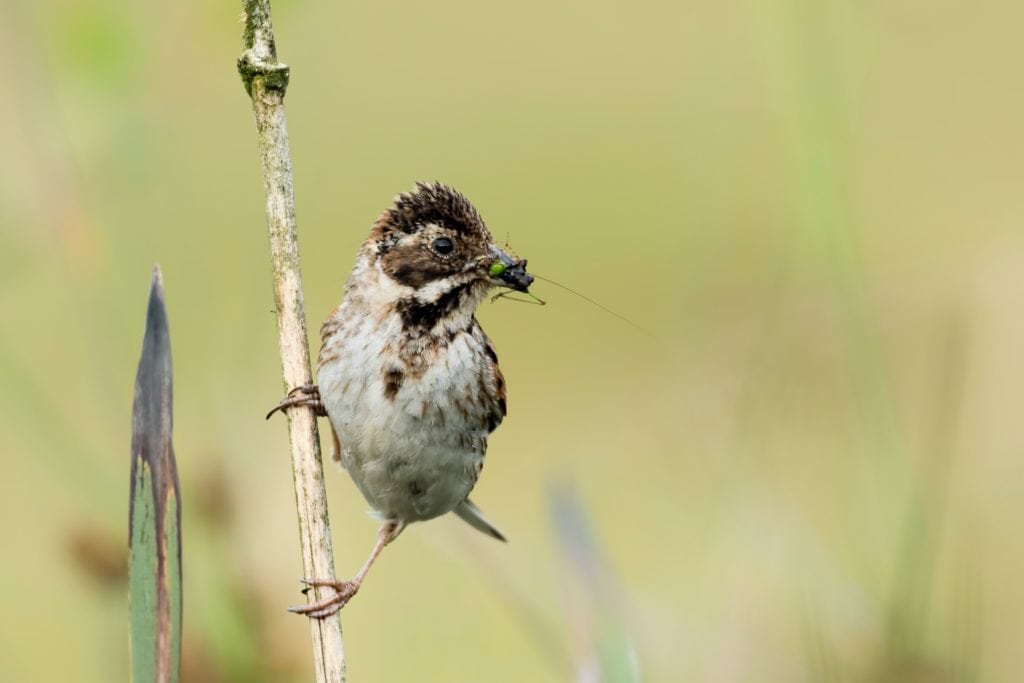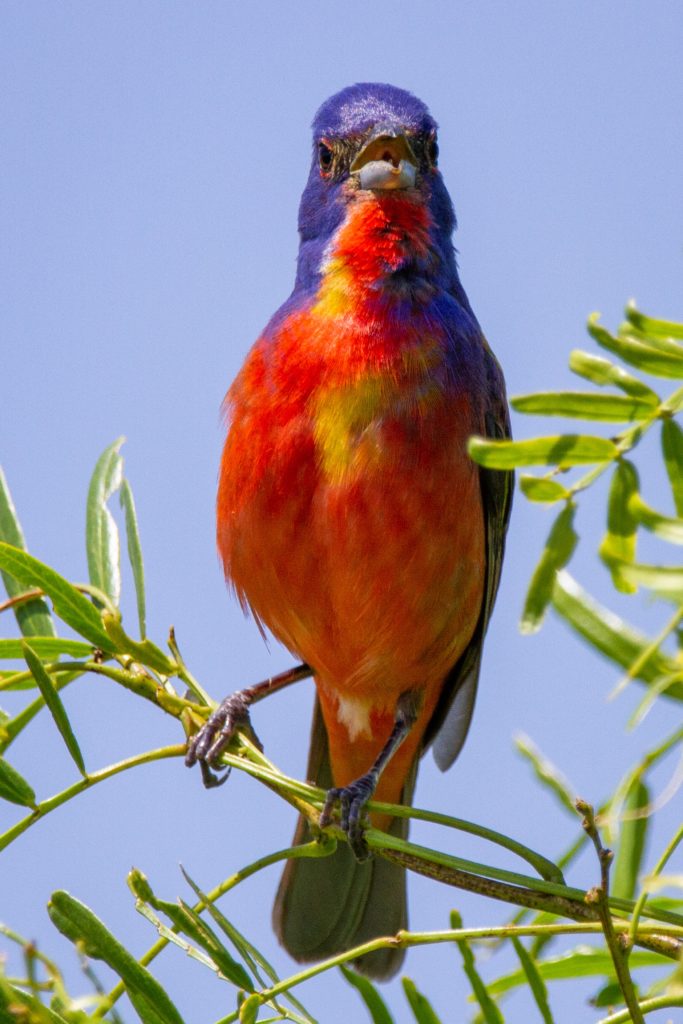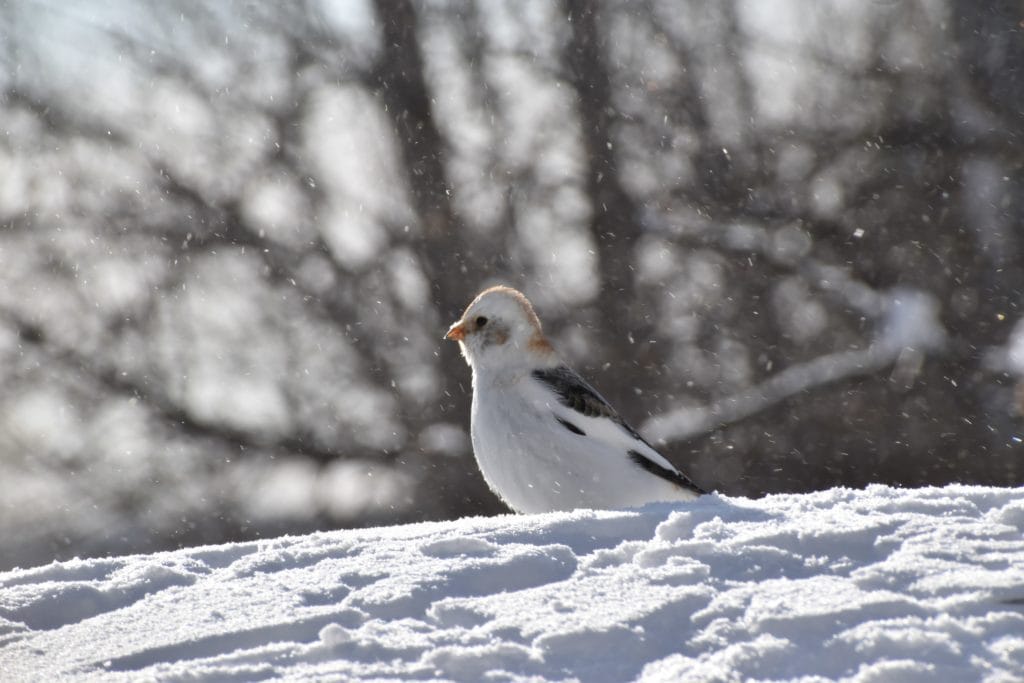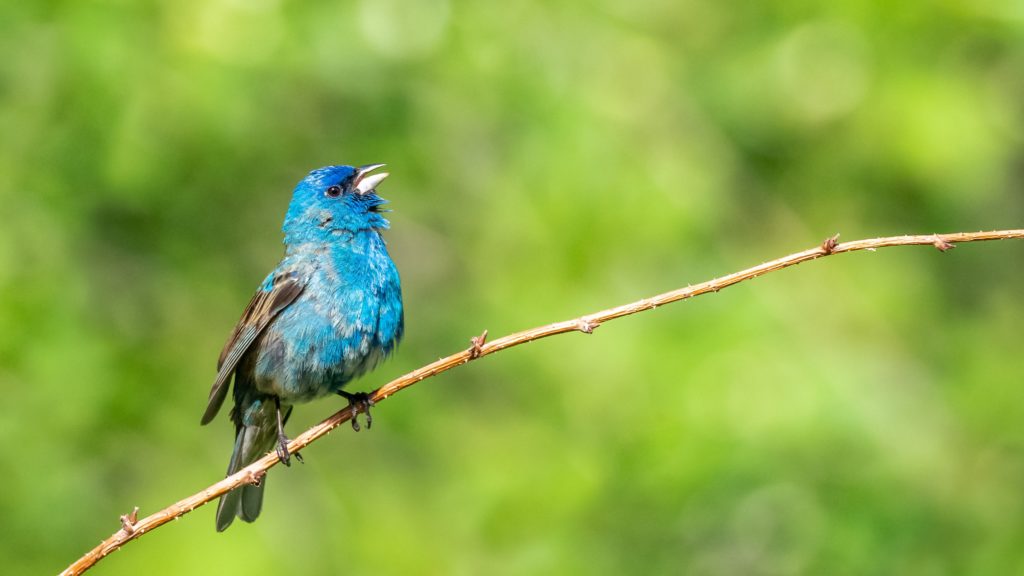Buntings are small seed-eating passerines, or songbirds, which belong to either the New World Passerina family of the Cardinalis genus, or the Old World Emberiza genus. A few other buntings, such as the Snow Bunting, belong to separate families altogether. (1) Across these genera, buntings are united by their sturdiness, their beauty, and their tendency towards colorful plumage. The Painted Bunting, which belongs to the New World Passerina family, is one of the most coveted songbirds in the United States and is beloved by birders nationwide.
Does the bunting hold a special significance in your heart? Read on to learn all about the meaning of these stunning songbirds.
Bunting Symbolism and Meaning
Buntings are often thought of as signs of good luck, of the bounty of nature, and of the changing of the seasons. Many different types of buntings exist, and many of the most beloved buntings are seasonal migrants who have cone to embody the seasons in which they visit. Spring and summer are the main seasons wherein one can enjoy a Painted Bunting visit in the United States. (2) Snow Buntings, on the other hand, are winter birds through and through. (3) During the warmer seasons they venture further north into the inhospitable tundra. In winter, though, Canadian birders and U.S. birders from the northern states can enjoy these cheerful visitors.
Buntings may also represent lost innocence, excess, gluttony, or sin. This is because of a dark tradition originating in French cuisine. The Ortolan Bunting is traditionally consumed whole after being overfed and drowned in Armagnac brandy. Traditionally, diners eat this meal with a cloth covering over their head. Legend has it that this is intended to hide this act of desecration from the eyes of God. (4) Diners are said to enjoy the crunching of bones whilst eating these birds whole. The tradition is problematic both for its cruelty and for the fact that it has actually significantly damaged the population of Ortolan Buntings. Although this dish has been outlawed, Ortolan Buntings still declined as much as 88% between 1988 and 2016. (5) Thus, the bunting may represent the cruel excesses which result from indulging one’s appetite without inhibition.

The Ortolan Bunting is, fortunately, an outlier. Most buntings are thought to represent the beauty of nature and the joys of experiencing its colors and songs.
Bunting Native American Symbolism
In Inuit symbolism, the Snow Bunting is a symbol of good luck. These hardy little birds are thought of as charms which ward off the dangers of a harsh winter season. (6)
Bunting Christianity Symbolism
The rainbow is one of the Bible’s most important and iconic symbols. In Genesis 9:9-14, the rainbow is presented as the sign of God’s covenant with Noah. It is his sign that the world has been purified and will no longer be subjected to the flood which had destroyed all life except that which was on Noah’s Ark:
“I hereby confirm my covenant with you and your descendants, and with all the animals that were on the boat with you—the birds, the livestock, and all the wild animals—every living creature on earth. Yes, I am confirming my covenant with you. Never again will floodwaters kill all living creatures; never again will a flood destroy the earth.” Then God said, “I am giving you a sign of my covenant with you and with all living creatures, for all generations to come. I have placed my rainbow in the clouds. It is the sign of my covenant with you and with all the earth. When I send clouds over the earth, the rainbow will appear in the clouds.” (7)
In Ezekiel 1:26-28, the rainbow is presented as a manifestation of God’s own glory. The light and radiance of God is embodied by the splendor of the rainbow:

“And above the firmament over their heads was the likeness of a throne, in appearance like a sapphire stone; on the likeness of the throne was a likeness with the appearance of a man high above it. Also from the appearance of His waist and upward I saw, as it were, the color of amber with the appearance of fire all around within it; and from the appearance of His waist and downward I saw, as it were, the appearance of fire with brightness all around. Like the appearance of a rainbow in a cloud on a rainy day, so was the appearance of the brightness all around it. This was the appearance of the likeness of the glory of the Lord.” (8)
These passages suggest, to me, that the Painted Bunting should be a bird which represents the brilliance of creation and the presence of God in all things. The rainbow hues of the Painted Bunting’s feathers may remind Christian believers of the great gift that God has given them: nature!
Bunting in Dreams
Have you been dreaming of the bunting? A bunting dream may represent a hidden treasure or reward at the end of a long journey. Birders often spend years hoping to spot the colorful visage of the elusive Painted Bunting. Keep moving forward and anticipate the glorious rainbows which follow the harshest of storms.
Dreaming of consuming a bunting may indicate an area of your life in which you feel incredible guilt. Remember that shielding yourself from your guilt is no way to atone. To rid ourselves of shame we must face our wrongdoings and accept them as part of the process by which we grow and learn.
Bunting Encounters and Omens
Encountering a bunting is a surefire sign that luck is on your side. These beautiful birds often appear to brighten our days and remind us that each moment on earth is special.
A bunting encounter could represent the desire to chase new horizons. Buntings tend to migrate and enjoy the beauty that the world has to offer throughout its seasons. So, a bunting dream may be a manifestation of wanderlust. Consider changing up your surroundings, planning a new adventure, or relocating to somewhere which excites you!
Bunting in Mythology & Folklore
Buntings, but especially Painted Buntings and Snow Buntings, appear in a number of legends and stories. Below are just a few of the more fascinating bunting myths!
Native American Mythology:
According to one Native American myth, the Painted Bunting received its beautiful colors from the Great Spirit. This legend states that the Great Spirit was responsible for painting all of the birds in all of their many beautiful colors. He painted the Northern Cardinal bright red and he painted the Blue Jay in shades of brilliant blue. When he had finished there was just one drab gray bird left. Eager to finish, the Great Spirit reached for his paints and found that he did not have enough left to paint this poor little bird. Noticing the sadness on the bird’s face, the Great Spirit told it not to cry because he would make it the most beautiful and colorful bird of all. So, the Great Spirit used all of his remaining paint to give the Painted Bunting splashes of color. Instead of one or two fine colors, the Painted Bunting boasts bright red, blue, and green feathers which rival even the brightest of cardinals or the bluest of Blue Jays. (9)
Several indigenous myths from North America’s northern reaches involve the hardy little Snow Bunting. Among these, many Inuit stories have been passed down through oral tradition for many generations.
One such story features a young woman who has a beautiful mellifluous voice which resembles that of a Snow Bunting. According to legend, this woman married a hunter named Pisiksi. Pisiksi loved the Snow Bunting woman, but before long she fell in love with another man. The woman left Pisiksi and ran away to be with her new love. Enraged, Pisiksi transformed into a bear and hunted the Snow Bunting woman down. In the form of a bear, Pisiksi slew the Snow Bunting woman. To this day, if you listen carefully to the song of the Snow Bunting, it is said that it sings “you are not Pisiksi” in the native language of the Inuit people. (10)

Another, very similar story, features a man named “Pisiksole.” Pisiksole had two wives but remained unsatisfied. One day, he left for a hunting expedition and never returned. His wives worried terribly for him until a Snow Bunting landed on when of their tent poles. The Snow Bunting cried out “Pisiksole has married.” So, the two wives, who were powerful shamans, transformed into seals and made their way to the camp of Pisiksole and his new wife. When they arrived, the women transformed into bears and slew Pisiksole. (11)
Japanese Mythology:
In traditional Japanese art, the Meadow Bunting is used as a motif to represent innocence and springtime. (12)
Greek Mythology:
The Painted Bunting’s scientific name, Passerina ciris, originates from a lesser known Greek myth. Scylla, who shares a name with a famous sea monster of Greek legend but who is, in this case, a beautiful young princess, was the daughter of King Nisus. Nisus ruled over the invincible city of Megara. Thanks to a precious lock of purple hair with which the gods had blessed him, Nisus was unbeatable in battle and he and his kingdom were utterly unassailable. One day, Scylla saw an invading force from the kingdom of Crete approaching the shores of Megara. Although she would ordinarily be disinterested in such things because the city could not be sacked, this time Scylla was fascinated. Leading the army was the infamous King Minos of Crete. Scylla fell in love with Minos instantly and decided to assist him in taking her father’s city. (13)
Scylla was aware of Nisus’s special ability, and so she decided to rob him of his purple lock of hair. Scylla snuck into her father’s chamber and cut the magical hairs from his head, rendering both Nisus and the city of Megara defenseless. To her surprise, though, when Scylla presented the hair to Minos and explained what she had done for him, Minos rejected her. Scylla’s untrustworthiness and lack of respect for her father repulsed Minos who immediately returned to his ship and sailed away from Megara. Desperate, Scylla leapt into the sea in an attempt to follow Minos. As she fought the ocean’s relentless waves, she transformed into a sea bird called “ciris.” In this form, Scylla was relentlessly pursued by her vengeful father who had assumed the form of a sea eagle. (14)
The Painted Bunting, Passerina ciris, is named after the story of Scylla and the “ciris” into which she was transformed. I have not been able to determine why this story was chosen to represent these birds, however it seems possible that their beauty could be connected with a young princess, treacherous as she may be. Perhaps the “ciris” name is attached because these birds are so vibrant and colorful as to resemble the stolen lock of purple hair? I have yet to find a more satisfying explanation than this, though it doesn’t make perfect sense. (15)
Bunting Spirit Animal
If your spirit animal is the bunting then you probably don’t even know the definition of “blending in.” The bunting spirit animal is all about letting your true colors show. Despite their tendency to express themselves loudly and proudly, people with this spirit animal are often quite shy. Because they cannot hide their true selves, they prefer to stick to the company of those who they know will accept them.

People with the bunting spirit animal are artistic souls who tend to crave new outlets for their creativity. They are adventurous, experimental, and sensitive.
Bunting Totem Animal
The bunting totem animal represents hardiness and rejuvenation. Like the unflappable Snow Bunting who is fearless in the face of the unforgiving cold of the tundra, people with this totem animal are impossible to keep down. Even when they feel defeated, a bit of TLC will always have the bunting totem bouncing right back.
Bunting Power Animal
The bunting power animal is associated with travelers. The migratory bunting brings joy and excitement wherever it roams. Call upon the power of the bunting for protection during your travels. People who embody the power of the bunting have a hard time staying in one place for too long and may consider the whole world their home.
Bunting Tattoo Meaning
A bunting tattoo may represent springtime, joy, the birdwatching hobby, vibrancy, or good luck.
A Christian with a Painted Bunting tattoo may choose this symbol to represent the rainbow which stands for the covenant between God and Noah and the awe-inspiring glory of God himself.
A Painted Bunting tattoo may also represent pride in oneself and individuality.
Conclusion
Whether you’re a birder looking to add a long-awaited Painted Bunting to your life list, or just someone who enjoys watching buntings of all kinds migrate through your area, the bunting brings joy to the gardens of nature lovers everywhere. These multicolored jewels of the avian world are reminders that birds, and nature itself, are an incredible gift that each of us is lucky to have the chance to appreciate.
